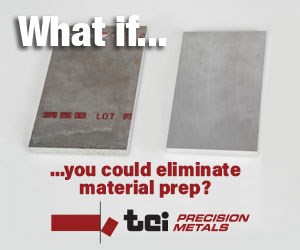The Value of Picosecond IR Laser Marking for Medical
Medical device manufacturers are the primary market for infrared laser markers that deliver pulses in picoseconds to deliver true-black, non-reflective marks on surgical instruments and implantables.

The medical device industry is the prime market for picosecond infrared (IR) laser marking systems. Source (all photos): DPSS Lasers
Machine shops have various part-marking alternatives from which to choose ranging from simple to sophisticated.
Alex Laymon is president of DPSS Lasers, which specializes in ultra-violet (UV), solid-state laser systems as well as other laser integrations. (DPSS Lasers is an Arch Cutting Tools company.) He says that appropriate part-marking tools for general machine shops might be as basic as a permanent black marker, dot-peening machine or hammer and punch. Laser marking, another alternative, is going to create a permanent mark, but that process will be more expensive to implement.
Laymon explains that a quality fiber laser system might start off at $30,000 and a high-resolution UV version at $70,000. These are compatible with various metals and create corrosion-resistant, annealed marks. There is no dimensional change to the part, and the part will not degrade or corrode due to any subsequent passivation or cleaning steps (or insertion into a human body for medical applications).
But Laymon says it’s important to consider that the fiber- or UV-laser marking processes will not adversely affect the part polish where marking occurs. The mark itself, which commonly has a grayish color depending on the material, will appear polished and reflect light. This could be undesirable for certain applications. Therein lies an advantage of the picosecond infrared (IR) laser marking system DPSS Lasers offers, which creates a “light trapping” affect and true-black part marking.

True-black marking is possible using picosecond IR laser markers.
As Laymon explains, a picosecond laser changes the structure of the part material on a nanometer scale without adversely affecting the part’s nominal dimensions. The tiny peaks and valleys generate a light trap, so the mark appears to be true black. Plus, unlike an annealed mark, there is no reflection off of the mark which could obscure it from view depending on the viewing angle or room lighting.
But Laymon notes that this system isn’t appropriate for all manufacturers. Price is the typical barrier given the cost can be three times that of fiber or UV laser systems. Plus, small shops are often fine with an annealed, grayish laser mark that is permanent and corrosion-resistant, albeit reflective.
Manufacturers of medical devices, however, are the biggest market segment that finds value in picosecond IR lasers. In fact, for DPSS Lasers, the medical device industry represents approximately 90-95% of the sales of such systems. For example, during surgery, it’s important for a doctor to immediately and clearly see depth bands on a catheter or drill bit at all viewing angles, which likely wouldn’t be possible due to light reflection off of an annealed mark.

Because of the “light-trap” effect, there is no reflection off of the mark which could obscure it from view depending on the viewing angle.
Other important marks can be the number or size of a drill scalpel or other medical device as well as data matrix codes that the FDA mandates. The laser’s high resolution enables the marking of very small codes on miniature components. Plus, virtually any implantable designed to remain in a human body requires a serial number for traceability. A laser can create these permanent serial numbers without changing the dimensions or structural integrity of those components.
U.S.-made and sourced DPSS Lasers picosecond IR laser systems for applications such as these typically are customized to a small extent to facilitate effective functionality (think accommodation of robotic part loading, part delivery to and out of the laser system and so on) as a part of an overall production line that would be designed by an integrator. A customer wouldn’t buy it to mark just one part; marking of multiple SKUs at high volumes is the goal. This also is a good reason to consider the source of the laser, Laymon maintains, especially for FDA-certified medical marking applications. Medical manufacturers must re-certify a marking process whenever a laser has to be replaced. Using a system with a lower-quality laser can result in much more frequent recertification processes and associated downtime.
Related Content
The Value of Swiss-Types Milling Rectangular Medical Parts
High-speed spindle technology was key to effective milling of small cardiac monitoring components complete on a CNC sliding-headstock machine platform instead of running them across two mills.
Read MoreGerman Project Yields Three New Medical Machining Processes
Recent research has resulted in a new mix of high-speed turn whirl milling, polygon turning and rotational turning for manufacturing medical bone screws and out-of-round nails.
Read MoreSome Assembly IS Required
This Colorado manufacturer added a separate facility dedicated to customer assembly work and inventory management to produce subassemblies and completed products primarily for medical customers.
Read MoreFive-Axis Machining for Small Prismatic Parts
New to the U.S. market, this compact machine could enable precision turning shops to win complex, more prismatic work in medical and other industries.
Read MoreRead Next
The Lost Art of Mastery
There is value to honing and mastering a craft. But it takes time and experience.
Read MoreApproach PMTS 2025 With a ‘Process’ Mindset
High-volume machining operations are more apt to think about the entire process of producing parts beyond the machine tools themselves. All such technology is presented at the 2025 edition of the Precision Machining Technology Show.
Read MoreA Tooling Workshop Worth a Visit
Marubeni Citizen-Cincom’s tooling and accessory workshop offers a chance to learn more about ancillary devices that can boost machining efficiency and capability.
Read More






















